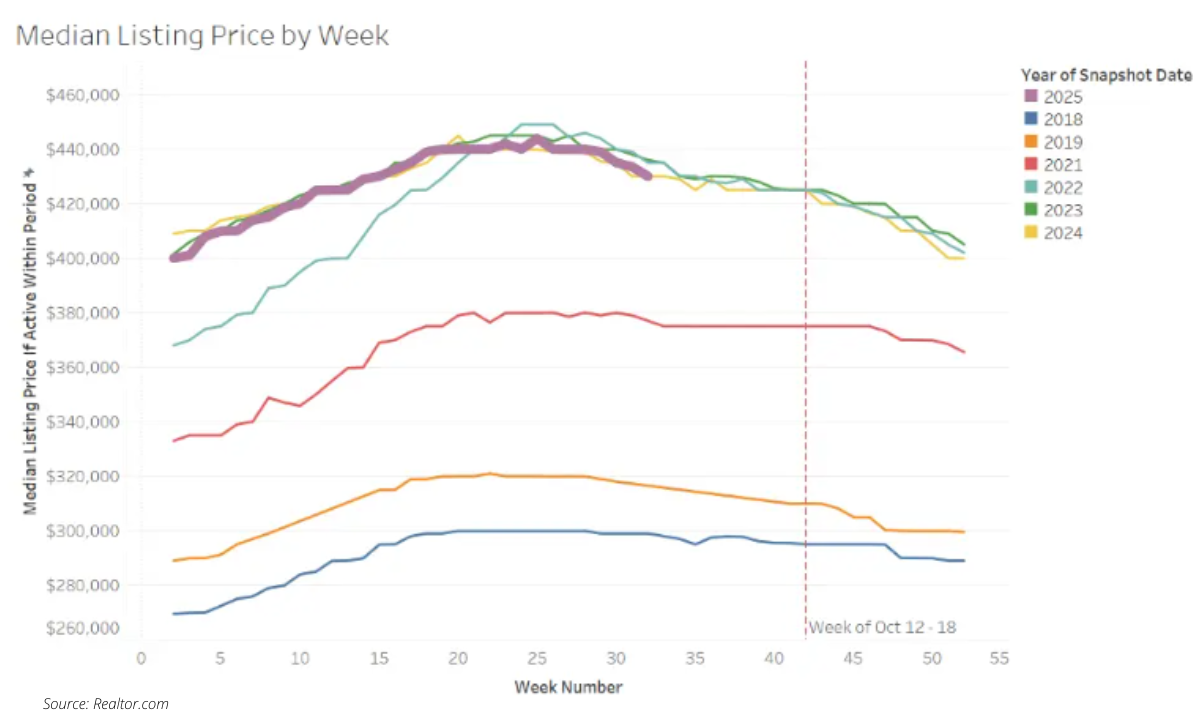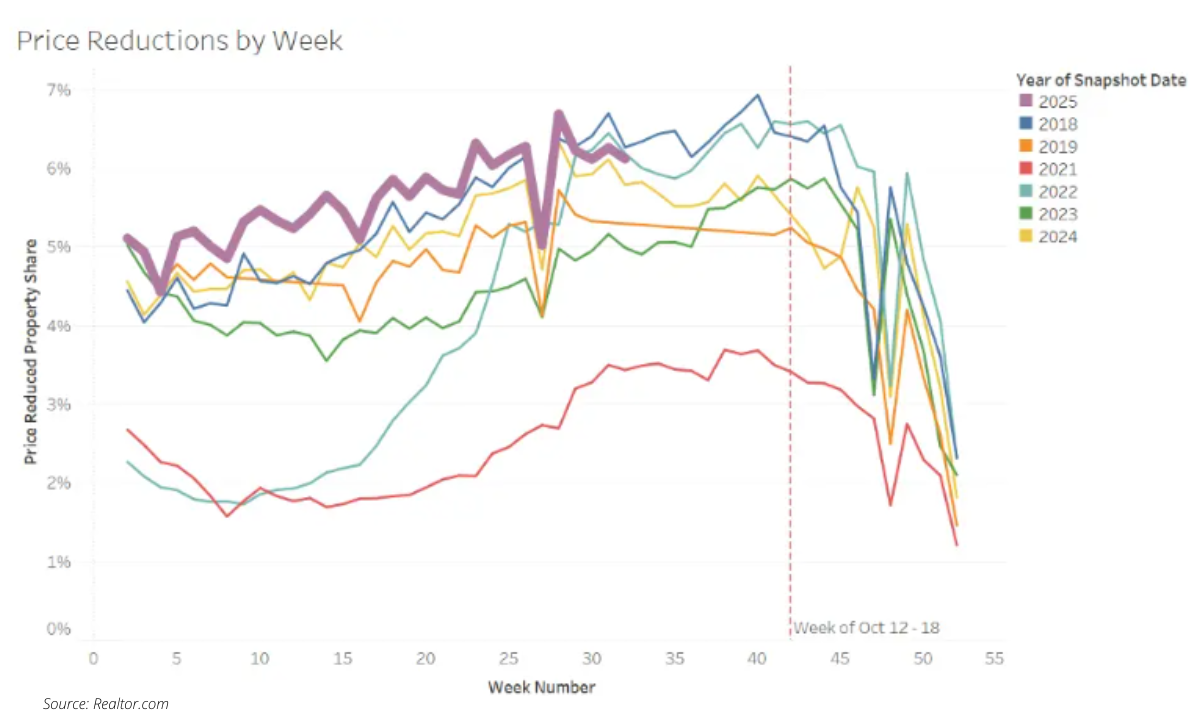Categories
Homebuying Tips, Utah Real Estate MarketPublished September 24, 2025
The Best Time to Buy a Home: October 12–18, 2025

If you’ve been keeping an eye on Utah’s housing market this year, you may be wondering when the best time to buy is. According to housing market data, the week of October 12–18, 2025, stands out as the most favorable time for homebuyers—not only nationally but also here in Utah. With higher inventory, softer prices, and less buyer competition, this mid-October window offers a unique opportunity for those ready to make a move.
Why October Is the Best Week to Buy a Home
Every housing market follows seasonal rhythms. Spring and summer are hot buying seasons—families move while kids are out of school, sellers list when curb appeal is at its best, and competition drives up prices. By fall, however, demand cools and homes linger on the market. That creates the perfect setup for buyers.
Here’s what makes October 12–18, 2025, particularly special:
-
More Inventory: Listings are expected to be 32.6% higher than the start of the year, giving buyers more options.
-
Lower Prices: Buyers could save around $15,000 compared to peak summer prices.
-
Less Competition: Buyer demand typically drops by 30% compared to spring’s peak, easing pressure.
-
Slower Market Pace: Homes spend more days on the market, giving buyers time to negotiate.
-
More Price Reductions: Historically, over 1 in 5 homes see price cuts in October, adding affordability.
-
Fresh Listings: Even in fall, new homes come on the market, often 15% higher than early-year levels.
For Utah specifically, October means a balance of choice and value. Buyers in areas like Salt Lake City, Lehi, or West Jordan will see more inventory compared to summer, while southern Utah markets like St. George may offer motivated sellers looking to close before the year’s end.
Utah’s 2025 Housing Market Snapshot
The first half of 2025 was steady, with home prices and mortgage rates holding close to 2024 levels. That stability reduced bidding wars, but affordability challenges persisted due to high costs. By summer, Utah—along with much of the U.S.—saw its highest inventory levels since 2019, though still slightly below pre-pandemic supply.
Here are a few highlights shaping Utah’s housing market this year:
-
Inventory Growth: Supply has improved significantly, giving buyers more options. Along the Wasatch Front, listings are up compared to 2024.
-
Vacancy Rates: Homeowner vacancy rose slightly to 1.1% in Q2, still far below historic norms. Many homeowners remain “locked in” with ultralow rates.
-
Economic Uncertainty: Tariffs, inflation pressures, and interest rate questions have slowed both new home sales and construction.
-
Regional Differences: The West and South are more buyer-friendly, with Utah falling into this trend, while the Midwest and Northeast remain tougher for buyers.
Despite lingering affordability challenges, Utah’s market has shifted toward balance. More listings and a slower pace give buyers breathing room, while sellers must adjust expectations from the frenzied pandemic market.
Is Utah Moving Toward a Buyer’s Market?
For years, Utah sellers had the upper hand. Tight supply, skyrocketing prices, and intense competition left many buyers frustrated. But 2025 is different. Inventory is at its highest since before the pandemic, and more homes mean less pressure to rush decisions or waive contingencies.
While the national market hasn’t fully tipped into buyer territory, Utah feels more balanced. In fact, some metros—like Austin, TX, and parts of the West—have already leaned buyer-friendly. In Utah, especially along the Wasatch Front, rising inventory gives buyers leverage they haven’t had in years.
For sellers, this means strategy matters. Homes still sell, but pricing competitively, staging effectively, and offering incentives are more important than ever.
Why Mid-October Stands Out
The timing isn’t random. Seasonal patterns explain why October 12–18 is prime buying season:
-
School Schedules: Families typically move in summer, so fall demand slows.
-
Weather: Cooler temps and shorter days reduce buyer urgency.
-
Lingering Inventory: Homes that didn’t sell in summer stay on the market longer.
-
Motivated Sellers: By fall, sellers may cut prices to close before the holidays.
This year, the slowdown could be even more favorable. After a sluggish summer, if mortgage rates ease in fall, demand might tick up slightly—but Utah’s growing inventory should absorb that surge, keeping conditions buyer-friendly.
Key Market Advantages in Mid-October
1. Plentiful Listings
Inventory tends to peak in early fall. This October, listings are projected to be 14.7% higher than the average week and near the year’s high point. For Utah buyers, that means better chances of finding a home that fits both budget and lifestyle.
2. Lower Prices
Nationally, prices dip 3.4% below seasonal highs in October. In Utah, where home prices can stretch budgets, this seasonal drop is significant. Buyers could save around $15,000 compared to summer prices.

3. A More Manageable Market Pace
In 2025, the average time on market nationwide is 58 days, slightly slower than pre-pandemic norms. For Utah buyers, this means no more 24-hour decision deadlines—there’s room to negotiate and consider options.
4. Less Competition
Demand drops significantly after summer. In Utah, where spring is highly competitive, this fall slowdown will give buyers much-needed breathing room. Historically, views per listing fall 30% compared to spring’s peak.
5. More Price Reductions
October historically marks the peak for price cuts, with 5.5% of listings reducing prices in a single week. In today’s market, reductions may even surpass that, giving Utah buyers more chances to score a deal.

6. Fresh Listings
Even in fall, new inventory comes online. October typically adds 15% more new listings compared to early-year averages, giving buyers both fresh options and discounted older listings.
Tips for Buyers: Plan for Your Priorities
How should Utah buyers take advantage of this fall market?
-
If price is your priority: Waiting until later in fall may mean deeper discounts, but fewer choices.
-
If variety is your priority: Buy earlier in October for more fresh listings, even if prices are slightly higher.
-
If timing is flexible: Use tools like mortgage calculators to “rate-proof” your budget and plan for potential shifts in rates.
No matter your goals, keep tabs on your preferred Utah neighborhoods, set up alerts for new listings, and be ready to act quickly when the right property appears.
What This Means for Utah Sellers
For sellers, October isn’t just about waiting for buyers—it’s about adjusting strategy. With buyers gaining leverage, sellers can stay competitive by:
-
Pricing realistically from the start
-
Highlighting home features that stand out (location, upgrades, energy efficiency)
-
Offering concessions such as covering closing costs or rate buydowns
-
Ensuring online marketing and staging are professional and appealing
A balanced market doesn’t mean sellers can’t win. It means success comes from preparation and competitive positioning.
Utah’s Local Market Sweet Spots
While most of the U.S. shares the October 12–18 “best week,” some metros have their own timing. In Utah, the Wasatch Front and St. George markets are likely to align closely with national trends. Expect higher-than-usual inventory, competitive seller pricing, and more room for negotiation across Salt Lake, Utah County, and Washington County.
Final Thoughts: Don’t Miss Utah’s Best Week to Buy in 2025
For the first time in years, buyers in Utah have breathing room. More listings, softer prices, and less competition all converge in mid-October, making it the ideal time to secure your next home. Whether you’re upgrading in Salt Lake City, buying your first place in Lehi, or relocating to southern Utah, this window could save you thousands.
📲 Thinking about buying or selling this fall? Contact the Red Sign Real Estate team today. We’ll help you take advantage of Utah’s shifting market—whether that means finding the perfect home at the right price or positioning your property to sell in a more competitive environment.





